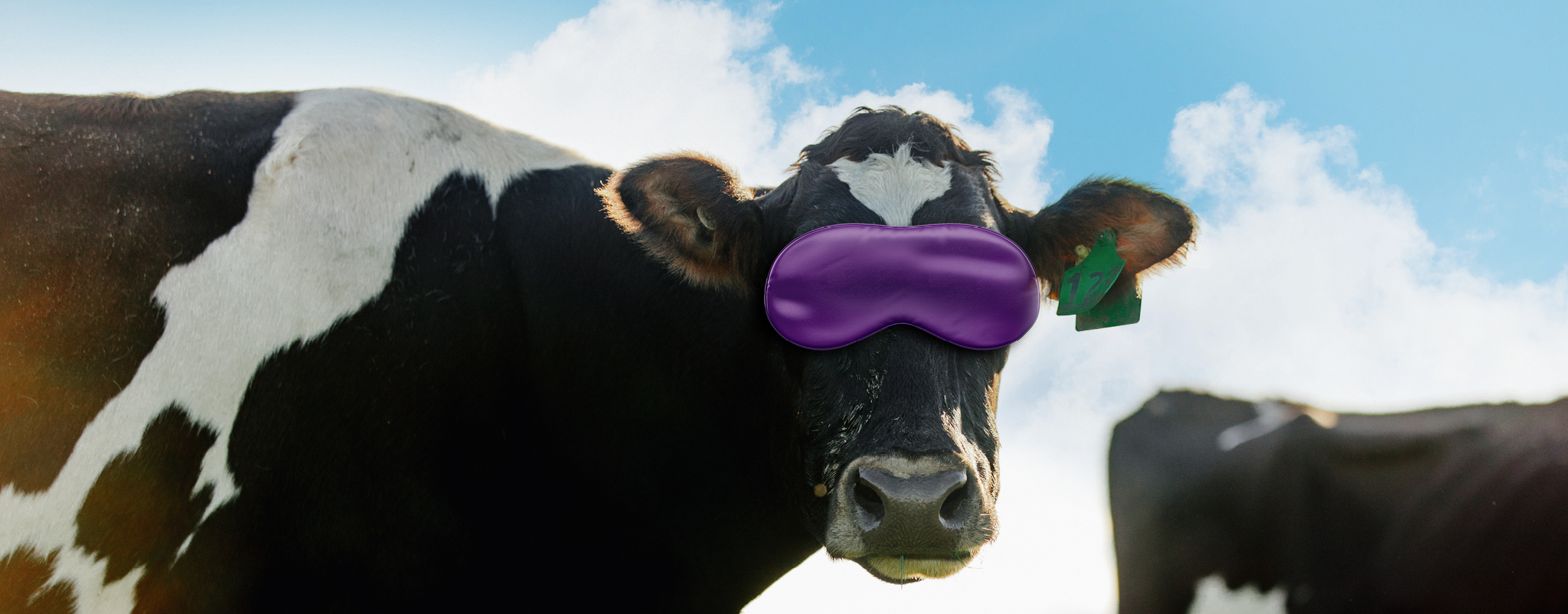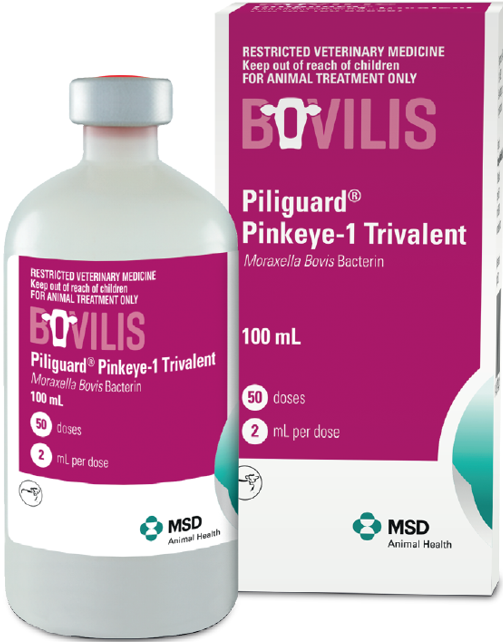
Prevent Pink eye
Piliguard® Pinkeye-1 Trivalent
Pinkeye in cattle is a painful and highly infectious disease which can cause temporary or permanent blindness.
Moraxella bovis is the primary bacteria that causes pinkeye in New Zealand cattle.
Bovilis Piliguard Pinkeye – 1 Trivalent is the only commercially available vaccine against Moraxella bovis.
Vaccinate with Bovilis Piliguard® 3-6 weeks prior to the expected onset of the pinkeye season.

Administering Bovilis Piliguard® Pinkeye-1 Trivalent
- A single 2mL dose by IM (intramuscular) injection to all classes of cattle. The vaccine should be warmed to room temperature prior to injection
- Animals should be vaccinated 3–6 weeks before the onset of the expected pinkeye season
- Annual revaccination is recommended
- Safe for use in pregnant cattle and has no adverse effect on milk production
- Nil withhold for meat or milk
- Available in 100mL (50 dose)
- Piliguard is recommended to be administered with a 2mL vaccinator gun and 16 gauge needles
CONCURRENT VACCINATION
Leptavoid 2 can be administered at the same time as either Covexin® 10 or Multine® without risk of detrimental immune response. Use alternative sites for administration. For more information on Animal Health Management, visit the Top Farmers Know How website
About pinkeye
Pinkeye (Bovine Kerato-Conjunctivitis) is an infectious disease of the eye that causes pain, inflammation, ulceration and in severe cases temporary or permanent blindness.
A number of micro-organisms can contribute to the establishment of Infectious Bovine Kerato-Conjunctivitis
(IBK), Cattle Pinkeye. These may be viral or bacterial (including Mycoplasma spp). The primary infectious agent
involved in pinkeye is the bacterium Moraxella bovis, which is carried in the nasal and ocular (eye) secretions
of carrier animals. Pinkeye in cattle is also precipitated by physical irritants such as dust, wind, flies and stalky grass.
Pinkeye occurs:
>> predominantly in young cattle, but cattle of any age can be affected
>> mostly over summer but can occur at other times of the year.
The first signs of pinkeye are appearance of weepy and squinting eyes. The cornea then becomes cloudy and a white spot can appear in the centre, these changes can be very small initially and easily missed especially from a distance. Some cases will clear at this stage, others progress to corneal ulceration and cloudiness that covers the whole cornea. At this stage the eye changes from a white to a pink to a yellow colour. Most corneal ulcers will eventually heal with varying degrees of corneal scaring that can impair vision. Corneal ulcers and corneal ruptures are extremely painful. In the most severe cases, corneal rupture will results in permanent blindness.
Health risks & diseases
BVD (Bovine Viral Diarrhoea) is a viral disease of cattle which is wide-spread in New Zealand. Affecting both dairy and beef herds, it is estimated that about half of herds are “actively-infected” with BVD at any given time1 and the cost of BVD to the New Zealand cattle industry is around $150 million a year.2
BVD causes pregnancy loss, diarrhoea, milk drop, and reduced growth rates. It also suppresses the immune system, making animals more susceptible to other diseases, such as pneumonia and salmonella.
Research in New Zealand and overseas shows that it pays to control BVD; it is always more cost-effective to do something than to do nothing3. Moreover, a well-executed BVD control plan will help you achieve other farm goals, like improving animal welfare, reducing antibiotic usage, and improving reproductive performance.
BVD is spread by “persistently-infected” or “PI” cattle. The key to BVD control is therefore to find and eliminate PIs from within your herd, then protect your herd from contact with outside PIs. This can be accomplished by: monitoring the herd, testing individual animals, improving biosecurity, and strategically vaccinating ‘at-risk’ cattle.
For more information about BVD, including how to test for and control BVD click here
1 Han, JH et al. (2018). Using Bayesian network modelling to untangle farm management risk factors for bovine viral diarrhoea virus infection. Preventive Veterinary Medicine. 161:75-82.
2 The BVD Management Toolkit. BVD Steering Committee
3 Weir, A. (2016). Epidemiology of BVD in New Zealand dairy herds. Massey University PhD thesis dissertation
For information about prevention with Bovilis® BVD vaccine click here
Neonatal diarrhoea is arguably one of the most common diseases of newborn calves worldwide. The consequences on animal welfare and those managing the calves can be devastating. The cost of mortality, poor growth and performance as well as treatment costs, all need to be considered. The infectious agents that cause neonatal calf diarrhoea are prevalent in New Zealand. In a recent survey 96% of farms in New Zealand had pathogens that can cause calf scours detected1.
For more information about calf scours and calf health in general click here
For information about prevention with Rotavec® Corona vaccine click here
Salmonella is a bacteria spread by healthy carrier animals via their intestinal tract. Cattle may not show signs of disease, but shed bacteria (usually intermittently at low levels) via their faeces. Abortive material can also be infective, spreading bacteria to other animals. These bacteria go on to infect other animals. Carrier animals can shed Salmonella for months or even years.
Due to the intensification of farming, BRD may have a larger impact on New Zealand in the future than what we have seen historically. Most cattle are susceptible to BRD at some point, and it can impact performance.
For information about prevention with Salvexin®+B vaccine click here
Pinkeye (infectious bovine kerato-conjunctivitis, or IBK) is a bacterial infection of the eye that causes inflammation and, in severe cases, temporary or permanent blindness.
For more information about prevention with Bovilis Piliguard Pinkeye-1 Trivalent click here


